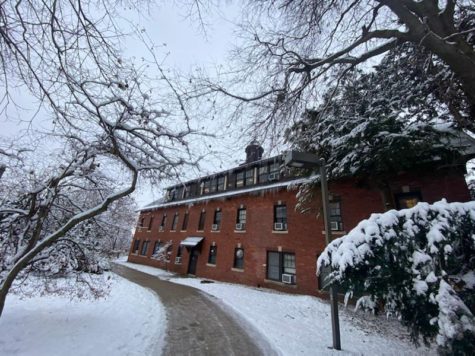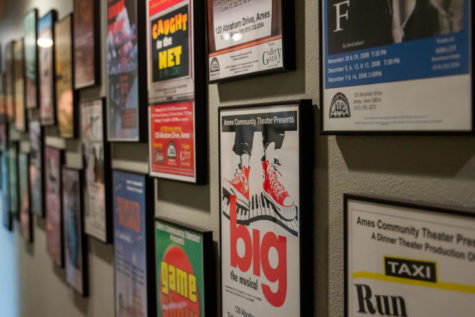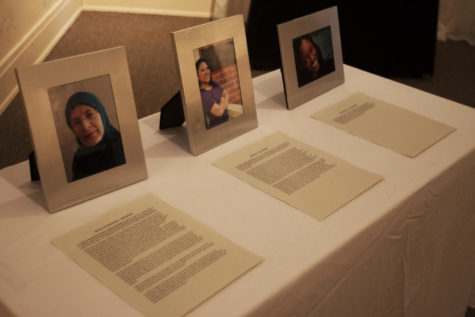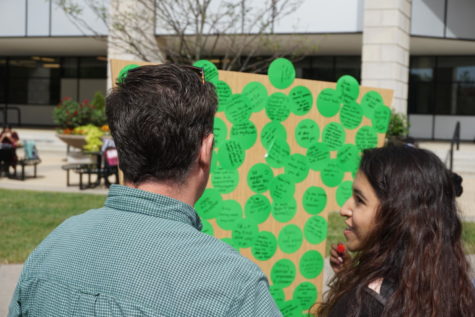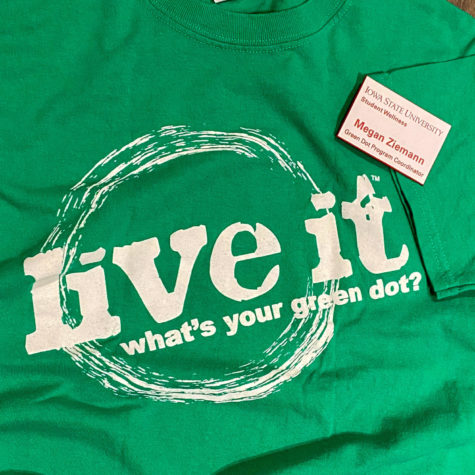Top 25 of Homecoming
October 26, 2012
Pep Rally
The year of 1912, the first homecoming, marked the first year Iowa State held a homecoming pep rally.
The meeting was held in Curtiss Auditorium and proved to be a huge success. Pep rallys became a main Homecoming event in the following years, and a bonfire was added to the event as well.
The pep rally evolved into a barbecue in the year of 1930. Approximately 3,000 students attended the pep barbecue, called “Hamburgers for Homecoming.”
The Homecoming pep rally, barbecue and bonfire was held in several different locations throughout the years, including State Field and the Beardshear parking lot among others, until moving to its current location — Central Campus.
Different activities have been added and taken away from the event throughout the years, but many activities have been a major part of the pep rally for decades. The football coaches and players still give speeches, Yell Like Hell finals are still held during the pep rally, and performances from the ISU Dance Team, Cheerleaders and Cy still bring the ‘pep’ to the rally.
The pep rally is held the Friday night of Homecoming and is not only a conclusion of the weeks festivities, but a way for Cyclone fans to get excited for the football game held the next day.
Lawn Displays
Lawn displays are one of the few traditions that have been key to Homecoming events from the very first year. While many traditions have been eliminated from ISU Homecoming lineup, lawn displays have not only remained, but grown and evolved into something more and more special each year.
The first lawn display came during the first ISU Homecoming in 1912. Engineering students created an electric sign, 55 feet long and 20 feer high, that read “Beat Iowa, Eat Iowa.”
In the following years, welcome signs were put up throughout Ames to get the town in the spirit.
In the early 1920s, lawn displays moved from streets to campus residences. A contest soon developed between houses. Houses would compete for a silver cup, but also to show alumni what they could do and how creative they could be.
Displays soon evolved in the following decades from two-dimensional banners and crepe paper, to three-dimensional structures in the lawns, to structures that incorporated mechanical features and sound effects.
The tradition’s popularity decreased in the next few years, only to be made popular again by one lone fraternity, who created a lawn display in efforts to not let the tradition die.
The next year, greek residences entered competition and in the following decades, policies were put into effect to establish rules to the creation of the displays.
Today, students in the greek community put in countless hours of work to create the lawn displays, which are judged by ISU faculty and alumni on categories such as creativity, organization and incorporation of the year’s Homecoming theme.
Creation of Iowa State University Alumni Association
As Homecoming is traditionally for the alumni, the Iowa State University Alumni Association is an integral part of Cyclone Homecomings each and every year.
The ISU Alumni Association aims to create a lifetime connection of alumni, students, and friends of Iowa State with one another as the central organization serving all members of the Iowa State family.
Created in 1932, the association was originally named the Iowa State College Alumni Association. The corporation was created for charitable and educational purposes. The ISU Alumni Association promotes the interest and welfare of ISU in many different ways.
As stated by the associations articles of incorporation, annual membership can be achieved by any graduate, former student, current student or friend of Iowa State upon payment and annual dues. “Honorary” Life Membership can be achieved by anyone other than alumni who has shown distinguished service and dedication to Iowa State and is selected by the Board of Directors.
An important part of Homecoming, and any football game, is the events at the ISU Alumni Center. The center opened in 2008 and has since served as a “home away from home” for ISU alumni and other members of the Iowa State family.
630 Club, Cyclone Club
The 630 Club was created after the Homecoming football game in 1946.
After World War II, the football team encountered tough times an tough losses. During the war, the Cyclones had been aided by players from schools across the country came to the area for military training.
Losing these players served as a challenge for the football team.
The 1946 Homecoming game was one of the toughest losses for the school. The Cyclones lost to Oklahoma 63-0. This game was a wake up call for Iowa State fans.
Fans created the 630 club, which aimed to improve the program both financially and in spirt.
Eventually, the 630 Club evolved into today’s Cyclone Club, which today, is just below the membership requirements of being one of the top-five athletics donor programs in the Big 12.
The Cyclone Club is critical in helping finance Iowa State Athletics, with generous donations from its members.
Creation of Cy the Mascot
Iowa State’s beloved mascot, Cy, came officially into play in the year of 1954, however, the Iowa State University Alumni Association found records of an earlier mascot in the ISU yearbook The Bomb.
According to the Alumni Association’s website, the Bomb reported that Pi Epsilon Pi introduced the first Iowa State mascot — a dog named Cy.
The records say that the dog stayed near the cheerleaders on the sidelines of football games. There are also records of the dog named Cy in 1933 and 1936, but no records in the following years.
The official mascot made its first appearance in 1954. It was then that it was decided by the ISU Pep Council that the Cyclones needed a mascot in order to generate more school spirit. The decision was soon made that creating a cyclone costume would be too challenging, the council chose a cardinal for the mascot, in honor of the Iowa State colors — cardinal and gold.
For $200, the first mascot costume was created and designed. A name-the-bird contest determined the decision to name the mascot Cy, after 17 people entered in the name.
Cy made his first appearance at the 1954 Homecoming game, where he was an instant hit with the fans.
Today, Cy is still an important part of all Cyclone athletics. Cy continues to hold a special place in the hearts of Iowa State fans everywhere.
Mass Campaniling
Anyone who knows anything about Iowa State’s campus knows that the Campanile is one of the most well-known and beloved symbols of Iowa State. And anyone who has walked through central campus on a sunny afternoon and seen the Campanile, which stands 110 feet tall, knows it is one of the most beautiful landmarks found on Iowa State’s campus.
The Campanile brings even more beauty to the campus at night. Not only does it look magical, it sounds magical — with 50 bells playing tunes every quarter of an hour. Besides its magical look and sound, the Campanile holds a magical tradition as well.
Tradition says that a student has not become a true Iowa-Stater until he or she has been kissed under the Campanile at the stroke of midnight.
During Homecoming, hundreds, even thousands, of students gather around the Campanile to kiss another at midnight. Those who have been mass-campaniling know that it can be not only extremely romantic, but a fun time as well.
Alumni Band
The Iowa State University Alumni Band Association was first created in 1979 after a graduate of Iowa State proposed the idea to the current directors of the ISU Marching Band.
The next week the idea was proposed to the Iowa State University Alumni Association, who then provided a list of marching band alumni.
The ISU Alumni Band Association, made of 165 members from the classes of 1927 to 1981, made its first appearance during the Homecoming of 1979. The band performed during the half time of the football game that weekend.
In the following years, the band has participated in events such as Veishea, and has performed as the Alumbi Pep Band at both men’s and women’s basketball games.
Today, the alumni band encourages anyone, graduated or not, who was previously a member of the Iowa State band, to become a part of the ISU Alumni band. Approximately 200 alumni return each year to play at the halftime of the Homecoming game.
The group also encourages spouses and family members to participate in activities throughout the weekend.
While Homecoming remains to be an event for the alumni, the Alumni Band gives past ISU students a way to continue to be a part of the Iowa State family.
The Run
Iowa State’s Homecoming game win over Texas Tech is perhaps the most memorable homecoming game in ISU history.
Not only did Iowa State win 31-17 over the Texas Tech Raiders, famous quarterback Seneca Wallace had an unforgettable play in the third quarter.
Known as “The Run,” Wallace zig-zagged a run totaling 135 yards on a 12-yard touchdown.
“The Run” put Wallace as a front runner for the Heisman trophy and continues to be one of the most amazing, well-known plays in ISU history.
Cyclones.com reports a transcript of the famous dash, as said by former “Voice of the Cyclones” Pete Taylor.
“Here’s Wallace, pumping, looking, running to his right, looking…and he’s going to be almost caught…now he’s running at the 25…and runs…down the sideline back to the 10! Now he’s giving ground, goes around the 10 to the left side, to the 5, touchdown! Oh my goodness, what a run by Wallace!”
Tournaments
The Saturday afternoon football game might be the most important game of the week, but it’s not the only.
Tournaments for Homecoming start the week prior to Homecoming.
Since the beginning of Homecoming, athletic events have been a crucial part of the week. The first Homecomings had freshmen playing the reserve football team in a game to entertain returning alumni.
The next few years brought additions to these athletic events — with competitions like pushball, arm wrestling and powder puff football making appearances throughout the week.
In the late 1970s, athletic tournaments became an official aspect of Homecoming, including novelty events such as weightlifting and tug-of-war.
Today, tournaments now include activities like bowling, mud volleyball, pool, darts and flag football. Less athletic activities such as Nintendo 64 and foosball have also been added to the tournament lineup.
Tournaments encourage student participation and friendly competition between students. Students can easily get into the spirit of Homecoming after participating in tournaments the week before, and with the large variety of activities offered, there is something for every ISU student to enjoy.
Pep Squads
Homecoming is about a lot of different things, but one of the most important is school spirit. Pep squads have been established throughout the years to excite fans and crowds and to instill an excitement in everyone.
The first representation of a pep squad begain during the first Homecoming in 1912, when a “Yell Leader” was chosen. This was a male student who led the crowd in cheers. The following years brought an addition to two or three more cheerleaders, and in 1915 the A-M-E-S Quartet began entertaining the crowd through their peppy songs sung through megaphones.
Throughout the following decades, more pep squads were established. 1924 brought the Twisters into the picture, and in 1938 females began to join the cheerleading squad. The Yellow-Jackets joined the Twisters as pep clubs, but both squads died in the 50s.
The cheerleading squad evolved in the 1940s to include stunts and acrobatics. Additionally, the marching band saw change with baton twirlers, fancier uniforms and moving field formations.
Cy mad his first appearance as an 8 foot cardinal in 1954, and in 1967, the ISU Pom Squad was established, which eventually became what is today’s Iowa State Dance Team.
Today, the pep squads are known as the ISU Spirit Squad which includes a mascot team, a cheerleading team divided into an all-girl squad and a co-ed squad and a dance team divided into a cardinal squad and a gold squad.
The Spirit Squad as a whole continues to make appearances at several Homecoming events including the pep rally and football game among many other events throughout the week.
The Homecoming Dance
The annual Homecoming dance began as a tradition with the very first Homecoming in 1912.
Win or lose, students would get together after the football game to celebrate the week as a whole.
In the 30s, the dance was one of ISU’s most festive and exciting events. The dance was sponsored by the Pep Club, and tickets were sold by club members.
During the dance, more than 4,000 students attended to dance the night away. Also during the dance, students could listen to a live band and find out the winner of the Homecoming Queen contest as well as the lawn display winner.
One year, the dance was so popular among students, music was piped from the Memorial Union to the State Gymnasium to accomodate the hundreds of couples who wanted to attend.
The dances featured live bands each year, and in 1950 famous Louis Armstrong and his band were the entertainment.
However, the Homecoming dances decreased in popularity and is no longer part of the Iowa State Homecoming festivities.
Homecoming Concerts
The Homecoming concert was a favorite event for a few decades before it decreased in popularity and eventually became a lost tradition.
In the 1960s, a homecoming concert was established as an alternative option to the annual Homecoming dance. The first concert was held in the Armory and was then moved to CY Stephens and Hilton Coliseum.
Each year, the lineup of the Homecoming Concert included popular names. Throughout the years, ISU students who attended the concerts were lucky enough to see entertainers such as Ray Charles, Neil Diamond and Three Dog Night.
The Bomb reported that Homecoming 1976 “might have been the longest homecoming in Iowa State history” after not one but two encores brought the Eagles back on stage at their concert in Hilton.
The concert began to lose popularity, but still secured big acts such as Elton John, Whitney Houston and Aerosmith.
With the creation of a new event on campus in 1983, the Homecoming Concert had competition. The Battle of the Bands eventually replaced the concert.
The Battle of the Bands featured local bands competing for a chance to play at Grand Daddy’s bar in Ames. The competition only lasted a few years, but was reestablished again in 2005 and continues to be a crowd pleaser today.
In 2007, the competition and concert were combined when the Battle of the Bands featured a headlining band.
The Parade
For the most part when one thinks of parades at Iowa State, Veishea is the event that comes to mind. However, Veishea isn’t the only celebration that has previously had a parade as part of the activities.
In the 1920s, the very first Homecoming parades featured horses, mules and wagons with signs and creative costumes.
Transformations ensued in the following decades. The parade saw its first change when the Scrap Heap Scramble was introduced. As part of this event, men’s residences and other campus groups would build cars made entirely out of scrap heaps. The entries were judged upon originality, mechanical ingenuity, humor, costumes and age and safety of the car by various faculty members.
The parade saw its next change when the parade began to follow a path marked by lighted flares across campus to the pep rally. This was called the Triumph March. During the parade, those participating would carry torches down the path to the pep rally.
In the following years, the parade then evolved into what was called the “snake dance.” Students would grab on to each other by the waist and snake down the chosen path. The cheerleaders, along with Cy, would lead the parade by the residence halls, picking up more students on the way, until it eventually ended at the pep rally on central campus.
The next transformation changed the snake dance into a parade of people marching through campus into the pep rally in 1990. During this version of the parade, people carried a life-sized Kansas Jayhawk dummy above their head, giving it to head coach Jim Walden to throw into the fire.
Today there is no longer a parade during Iowa State’s Homecoming week. It’s just another casualty to add to the list of lost Homecoming traditions.
Class Break
The first Homecoming started what the students felt should be an annual tradition. That very first year, ISU president cancelled classes on Friday and Saturday of that year’s homecoming.
Students began demanding class breaks, with no luck, until the 1930s. It was then that students took action and created their own class break. A group of students disrupted class by barging into classrooms and recruiting students to join their group.
The entire group then began participating in a spontanous pep rally and stree dance in front of what is now Beardshear Hall. This version of the class break lasted for approximately a decade.
The homecoming of 1949 brought a new version of the class break. In thisy ear, more than 3,000 students marched on the knoll during the Thursday night of Homecoming week. These students chanted “No School Friday.” At first, the then president of Iowa State refused. He eventually gave in to a special holiday after Friday afternoon to appease the riot.
Then he promised no school Monday if the football team won the football game on Saturday. This deal remained intact for the next few years, until the class break was forgotten as a whole and eventually completely disappeared from the list of ISU Homecoming traditions.
The Torchathon
Yet another one of Iowa State’s lost homecoming traditions comes in the form of the Torchathon. This event began in 1981.
27 runners from Iowa State ran a torch relay from the University of Missouri, which was the rival for the Homecoming game that year.
The runners related the torch from the University of Missouri to Ames, where the torch was presented at the pep rally.
The Torchathalon proved to be a success and earned a place as an annual ISU Homecoming tradition.
Each year, runners would relay the torch from the opponent’s stadium to Jack Trice Stadium. They would make the journey through the tailgating lots and finally make it to the field where it would be presented during the pregame activities.
1986 marked the longest route of the Torchathon, when the rival of the year was the University of Wyoming. 50 runners carried the torch 800 miles over five days.
The Iowa State Homecoming Torchathon became the longest collegiate marathon of its type in the entire country until it became a nonexistent event in the late 1990s.
Riot of 1953
It is possible that the Homecoming in 1953 is the most famous — or perhaps infamous — Homecoming in Iowa State’s history.
It was this year that the riots by the students got coverage from national news sources across the United States.
The football game that Saturday was one of the most exciting games in Cyclone history. The Iowa State football team upset the University of Missouri in a game 13-6, causing great excitement among fans and students.
Maybe a little too much excitement.
Students walked to Iowa State’s president James Hilton’s home where they chanted “No School Monday.” It wasn’t long until the students realized that Hilton was not at home. The riot made its way down Lincoln Way, which was then U.S. Highway 30.
There, students staged a sit-down on the street, again demanding “No School Monday.” The riot evolved to get more violent. Members in the crowd carried and dragged lawn displays down the street and proceeded to set them on fire.
Ames police and police officers from nearby towns came for crowd control, but ended up having to use clubs and tear gas in attempt to calm the crowd. Students fought back — using eggs, rocks and pumpkins as weapons against the police.
Eventually, the crowd dispersed and students went to class on Monday in reluctance.
However, the riot returned again that night, chanting “We want Tuesday off.” President Hilton promised the idea would be considered following the next win. The angry crowd replied by saying “We may not win another game.”
The riot continued to grow in anger, and began to barricade the highway until eventually the crowd dispersed and students went home.
These riots gained fame not just among Ames and the state of Iowa, but also across the nation. Famous news sources such as The Los Angeles Times and Life offered coverage of the riots.
Riots of 1997
Yet more riots occurred during the 1997 Homecoming. The Cyclones battled Baylor’s football team in an attempt to end a 13-game losing streak. End it they did.
Iowa State won over Baylor 24-17 to end the streak. Hundreds of Cyclone fans rushed the field, bringing down goal post in the process. The goal post was then carried to Lake LaVerne, where the mob of people tossed the goal post into the lake.
Along with the goal post, the excited crowed tossed in a stop sign, the swan crossing sign, a dumpster, a light post and several barricades.
By the end of the riot, a dozen people were arrested. A few people were also injured in the process.
It required special equipment to get the various objects out of Lake LaVerne, and the cost of replacing the goal post in Jack Trice Stadium totalled thousands of dollars.
Banner Contests
Lawn displays may be the most well-known of Homecoming decorations in Ames, but they are not the only display of spirit. Victory Lane and the banner contests both have give opportunities for students to display their Cyclone spirit.
The first banners were on display during the first Homecoming in 1912. These banners read “Welcome Alumni” until the 1960s, when an official banner contest was established.
Typically, Greek houses would compete with each other to be the winner of the banner contests. Winners would be announced at the same time that the lawn display champions were announced during the pep rally, or sometimes during the Homecoming dance intermission.
Banner contests decreased in popularity in the early 70s, only to gain popularity again in the 80s. During these decades, the locations of the banners moved from Central Campus, to the lawns of Greek houses, to in front of the football stadium, back to Central Campus.
Today, banners are made by the Greek houses as part of their Homecoming week-long competition. Students walking down Central Campus can see the different banners put together by the Greek houses and can enjoy another display of Cyclone pride.
Victory Lane
Victory Lane is yet another way for students and fans to put their school spirit on display. Started in the 1980s, students, faculty and staff would take part in the decoration of Victory Lane.
Participants would paint a 4 foot by 4 foot square on the cement in the parking lot just north of Jack Trice Stadium. The painting would show off Cyclone pride and school spirit, often incorporated with the chosen theme of the year.
Often times organizations would take part in decorating their own square. Participants include most often Greek houses, but residence halls and campus clubs have also participated in the painting of the square.
Established originally for the Cyclones football team, the players would walk over the painted cement after a winning Homecoming game.
Since the establishment of Victory Lane, Jack Trice Stadium has undergone remodeling. Since this remodeling, the football team no longer walks across the lane.
Victory Lane, however, remains a Cyclone Homecoming tradition. The painted squares give students even more opportunities to show their pride in Iowa State.
Yell Like Hell
Yell Like Hell is a newer tradition, but a favorite activity among many ISU students.
First established in 1963, Yell Like Hell gave residence halls an opportunity to submit an original yell. The yell was then judged on three categories: enthusiasm, originality and appropriateness. During the Homecoming pep rally, the five finalists would perform their yells again for the crowd.
This soon became an annual tradition and a favorite one as well.
Initially. the competition consisted of a 10 minute skit, a poetry reading and a cheer. The first years’ competitions were located behind the Armory.
The Yell Like Hell competition evolved in 1970 to have separate competitions for residence halls and Greek houses. The residence halls participation soon decreased enough that Yell Like Hell only had Greek houses competing.
The competition evolved and so did the yells. Yells went from one simple yell to a recitation of Iowa State’s fight song. The yells went under another transformation when the yells were skits that integrated superstitions, locations on campus and team rivalries.
The 1980s brought on another transformation for the competition. New judging categories were introduced. These categories included demonstrating school spirit and use of Iowa State’s cardinal and gold colors. This led to the current tradition of students painting themselves head to foot in cardinal and gold.
In 2001, another category was introduced to the competition — improvisation. This category required students to integrate a word they were given into their skits just minutes before their performance.
In the following years, a stomp section has become part of the yells and skits, in which participants would clap, slap their thighs and participate in choreographed stomping combinations.
Today, Yell Like Hell is a complex combination of yells, chants, the Iowa State Fight Song and choreography. After three rounds of elimination and being judged on creativity, enthusiasm, movement precision, integration of the improvisation word, incorporating the year’s Homecoming theme, and yelling expression.
Awards for best overall performance, choreography, costumes and script are also given.
The pep rally provides the time and location for the final round of Yell Like Hell. The Friday night of Homecoming week, students– both Greek and non-Greek — alumni and members of the community gather to watch the finalists compete and to enjoy the display of Cyclone spirit.
This tradition is unique to Iowa State and an exciting way for the crowd to be a part of the spirit and enthusiastic nature of Cyclone Homecomings.
For I, For S, Forever
The Homecoming in 1953 was not only the year of the infamous riots, but also a big year for the marching band.
It was in this year that the marching band saw an increase in members. With shiny new uniforms, the addition of baton twirlers and the incorporation of more advanced moving field formations, the marching band was well on its way of being an even more integral part of football games and of Homecoming festivities.
Also in this year, a favorite Iowa State pep song was introduced to the fans during the half time of the Homecoming game.
This song, “For I For S Forever” was written by famous composer Meredith Wilson. Wilson was the author and composer of well-known musical, “The Music Man.”
“For I For S Forever” was an instant hit with Cyclone fans in the crowd, and continues to be a crowd favorite during sporting events today.
Food on Campus
The first Homecomings included pep barbecues as activities alongside the favorite ISU pep rally.
Since then, the pep barbecue has been eliminated, and then brought back in a new form.
Iowa State’s first pep barbecue was held during the Homecoming of 1930 in the form of “Hamburgers for Homecoming.”
Hamburgers for Homecoming provided meals for students including steak, beans, pickles, apples and coffee for 3,000 students. This event was the first time the entire campus was able to eat as a whole group since the burning of Old Main.
The event was also the first time Greek houses did not serve any evening meals.
Also during the barbecue, which was joined by events such as the pep rally and bonfire, provided entertainment as well. Students could see the men’s quartet, pajama relays and fixed boxing matches.
During World War II, the country saw a shortage of ground meat. This changed the name from “Hamburgers for Homecoming” to “Wieners in Wartime.”
The barbecue and bonfire has jumped from location to location over the years and eventually moved to Central Campus.
As the pep rally grew in popularity, the bonfire and barbecue decreased in attendance and was eventually taken from the list of activities in 1970.
The barbecue made another appearance in the 90s, as a new version of the event. This event was in the form of a buffet. Held in Hilton Coliseum, it served approximately 3,000 students and alumni before the football game.
The buffet has since become tradition as a pregame meal and continues today in the form of the Cyclone Central tailgate inside the Iowa State Alumni Center prior to each home football game.
The pep barbecue came back in another version in the mid 1980s as a mass sack lunch on Central Campus.
1985 saw around 50 “brown-baggers” before the lunch gained popularity and transformed to one lunch during Homecoming week to a number of barbecues and other meals.
“Food on Campus” was established in the 2000s. This event allowed for a meal to be served every day during Homecoming week on Central Campus.
The event attracts more than 1,000 students, faculty and staff each day. Meals typically served include pizza, pork burgers and walking tacos among other things.
Students can eat a meal each day with a purchase of a Homecoming button for just $5.
Food on Campus provides an opportunity for students to gather for lunch and encourages collaboration and bonding between students during the week of Homecoming.
Homecoming 2012
This year marks Iowa State’s 100th anniversary of Homecoming. In celebration of this monumental milestone, the university has adopted the name “Cytennial” Homecoming Celebration.
Homecoming will “take Ames by storm” as Cyclone Football battles the Baylor Bears on Saturday.
Other highlights of this year’s Homecoming events include mini reunions for alumni to meet in the ISU Alumni Center, a pep rally sponsored by the Iowa State University Book Store, a pancake feed, fireworks and mass campaniling traditions.
Also included is “ExCYtement in the Streets.” After the Pep Rally and the Centennial Celebration, ISU students and alumni are encouraged to walk to the Greek houses to see the year’s Homecoming lawn displays.
The Cyclone Central Tailgate will be held as usual prior to the kick off.
This year’s 100 year anniversary and Cytennial Celebration proves to be a continuation of the ISU Homecoming activities, spirit and tradition that the university, students and alumni have grown to love.
GO STATE!







